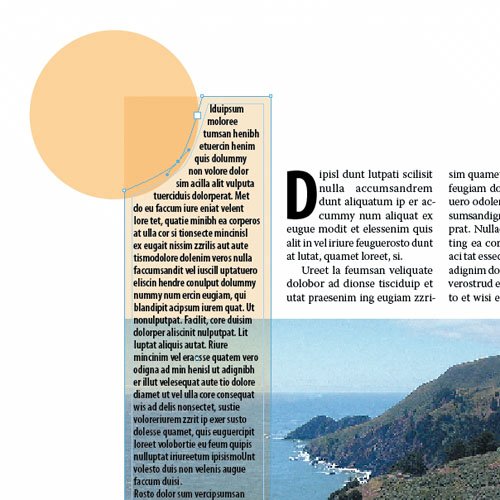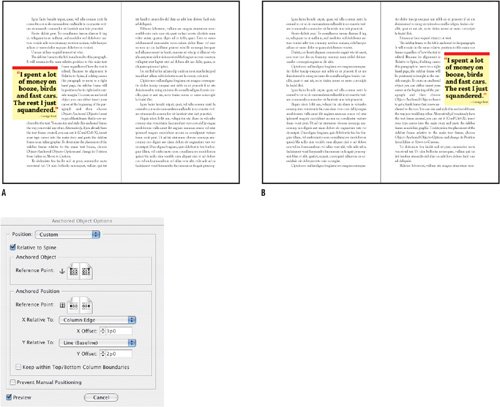Creating a Typography Workspace
Anchored Objects
A discussion of text wraps wouldn't be complete without mentioning anchored objects, a great new feature of InDesign CS2. If you've ever positioned a graphic, a caption, or a pull quote next to its associated piece of text only to have to reposition it when the text is edited, then you'll appreciate anchored objects. "Inline graphics" have been around for years. If you want a graphic inserted into the text flow, you cut it to the clipboard, place your pointer in the text frame (usually on a separate line) where you want the graphic to go, then paste it. Thereafter it moves with the text, remaining "anchored" to its position in the text flow. You may have to futz around with its position relative to the text and certain unpredictable things may happen, but for the most part it's an approach that works. Until, that is, you want to position a graphic relative to a portion of text, but outside the text frame. Cue anchored objects…
Figure 17.16. The sidebar article in the left column wraps around the circle shape, but ignores the text wrap applied to the picture (necessary to offset the body text in columns 2 and 3).

Anchored objects can be positioned outside a text frame and will maintain their relative position to that text frame no matter what. You can even have them positioned relative to the spine, so that the anchored object is always outside the text frame it is anchored toin the left margin for left pages, the right margin for right pages.
An anchored object can be a text frame, a picture frame, or any combination of grouped objects. You can evenand this is why I include them in this chapterapply text wraps to anchored objects. However, when you do so, the wrap doesn't apply to the line preceding the object. Don't ask me whyit just doesn't. But here's the workaround: Use a Y offset instead.
To create an anchored object, insert your cursor at the beginning of the paragraph and then choose Object > Anchored Objects > Insert to get a blank frame that is anchored to the text. Alternatively, if you already have the text frame created, you can cut it (Cmd+X/Ctrl+X), insert your type cursor into the main story, and paste the sidebar frame as an inline graphic. To determine the placement of the sidebar frame relative to the main text frame, choose Object > Anchored Objects > Options, and change its Position from Inline or Above to Custom.
Figure 17.7. The sidebar frame is anchored to the adjacent paragraph in the text. It will remain in the same relative position to this paragraph regardless of how the text is edited. Because its alignment is Relative to Spine, if editing causes this paragraph to move to a right-hand page (example B), the sidebar frame will be positioned to its right in the outside margin.

Part I: Character Formats
Getting Started
- Getting Started
- An InDesign Type Map: Where to Find Stuff
- Viewing Your Page
- Creating a Typography Workspace
- Up Next
Going with the Flow
- Going with the Flow
- A Blank Sheet: Typing on Your Page
- Text Flow
- Threading Text Frames
- Using Placeholder Text
- Pasting Text
- Importing Word Text
- Up Next
Character Reference
- Character Reference
- Less is More, Maybe
- Type Anatomy
- Type Classification
- Character Formatting Options
- Readability
- Up Next
Getting the Lead Out
- Getting the Lead Out
- How Much Is Enough?
- (Not) Using Auto Leading
- Keep It Consistent, Except. . .
- Leading Menu Options and Keyboard Shortcuts
- See Also
- Up Next
Kern, Baby, Kern
- Kern, Baby, Kern
- When to Kern
- Metrics Kerning
- Optical Kerning
- Manual Kerning
- How Much to Kern
- Tracking
- When to Track
- Controlling Widows and Orphans
- Up Next
Sweating the Small Stuff: Special Characters, White Space, and Glyphs
- Sweating the Small Stuff: Special Characters, White Space, and Glyphs
- Typographers Quotes
- Apostrophes
- Dashes
- Ellipses
- End Marks
- White Space Characters
- The Glyphs Palette
- Footnotes
- Footnote Options
- Up Next
OpenType: The New Frontier in Font Technology
- OpenType: The New Frontier in Font Technology
- Ligatures
- Discretionary Ligatures
- Ordinals/Raised and Lowered Characters
- Swash Characters
- Fractions
- Oldstyle Figures
- Contextual Alternates
- Opticals
- Glyph Positioning
- Stylistic Sets
- Up Next
Part II: Paragraph Formats
Aligning Your Type
- Aligning Your Type
- Centering Type
- Clean Shaven or Rugged: Justified vs. Ragged Type
- How InDesign Justifies Type
- Balancing Ragged Lines
- Right-Aligned Type
- Optical Margin Alignment
- Indent to Here
- Vertical Alignment
- Up Next
Paragraph Indents and Spacing
First Impressions: Creating Great Opening Paragraphs
- First Impressions: Creating Great Opening Paragraphs
- Creating a Simple Drop Cap
- Drop Cap Aesthetics
- Tricks with Drop Caps
- Up Next
Dont Fear the Hyphen
Mastering Tabs and Tables
- Mastering Tabs and Tables
- Setting Tabs
- Creating Decimal Tabs
- Using Tab Leaders
- Reply Forms
- Numbered Lists
- Right Indent Tab
- Working with Tables
- Creating a Table
- Working with Rows and Columns
- Working with Table Cells
- Up Next
Part III: Styles
Stylin with Paragraph and Character Styles
- Stylin with Paragraph and Character Styles
- Creating Styles
- Applying Styles
- Editing Styles
- Redefining Styles
- Creating Default Styles
- A Typical Style Sheet
- Up Next
Mo Style
Part IV: Page Layout
Setting Up Your Document
- Setting Up Your Document
- Choosing a Page Size
- Determining Margins
- Determining Column Width
- Changing Columns
- Break Characters
- Page Numbers
- Section Markers
- Up Next
Everything in Its Right Place: Using Grids
- Everything in Its Right Place: Using Grids
- Things to Consider
- Your Grid Tool Kit
- Calculating the Height of the Type Area
- Align to Grid
- First Baseline Options
- Snap to Guides
- Up Next
Text Wraps: The Good, the Bad, and the Ugly
- Text Wraps: The Good, the Bad, and the Ugly
- Applying Text Wraps
- Wrapping Type Around Irregularly Shaped Graphics
- Text Wrap Preferences
- Ignoring Text Wrap
- Anchored Objects
- Up Next
Type Effects
EAN: 2147483647
Pages: 186
